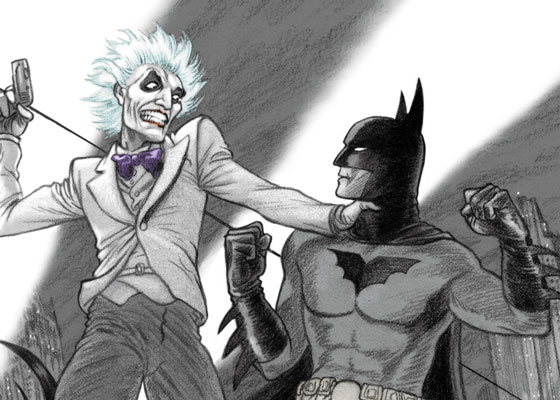 Illustration from Batman: Death and Design by Dave Taylor
Illustration from Batman: Death and Design by Dave Taylor
In midtown Gotham a construction crane collapses, narrowly missing Bruce Wayne during his public address to announce the demolition of the city's Grand Central Station to make way for a new ultra-modern replacement. So begins the Caped Crusader's first 'architectural' adventure, involving a corrupt union boss, an egocentric architect, a beautiful heroine, and a new villain - part-vigilante part-architectural critic.
This latest storyline was the vision of writer, graphic designer and lifelong Bat-fan, Chip Kidd. When DC Comics offered him his dream project he approached it from a totally personal perspective -- marrying his passion for design with his love of comic books. "Batman: Death by Design" was born. Kidd told me that he came up with the title first. To find a title that had not been used in the Superhero's 50-year history was a challenge in itself, but most importantly it fitted with the characters and the storyline that he wanted to create. Bearing in mind the importance of continuity when writing new material for a long-established comic-book character, he wanted to take a classic approach, and set his story in Gotham in 1939.
Limited to 100 pages by DC Comics, Kidd thought that leaving out Robin would be one less complication to the plot and give more space to develop new characters. Batman devotees are generally not huge fans of Robin anyway. He also decided to drop Commissioner Gordon, simply because he wanted his Batman to be an outlaw with the police out to get him. But classic characters, such as deranged, psychotic arch-enemy The Joker are included, along with Alfred, the loyal butler. He knows that Bruce is secretly Batman and his lifelong service makes him his closest ally.
Coincidentally the next Christopher Nolan-directed Batman movie, The Dark Knight Rises, released in July after this new graphic novel was published. The contemporary Hollywood portrayal of Bruce Wayne is as a psychologically scarred individual whose alter ego is a ruthless vigilante. In contrast, Kidd's Batman has no problem with his identity and the story is all about the adventure, written with an innocent sense of humour.
That said, the situations in the novel are based on real-life events. The storyline of the proposed demolition of Gotham's Grand Central Station is heavily based on the publicly opposed destruction of New York's Pennsylvania Station in 1963. Likewise, the collapse of construction cranes in Manhattan in 2008 and 2010, are also referenced in the novel's plot. In fictional Gotham, Batman is there to root out the cause of the disasters and its implications for the future of the city. There is a vital resurgence in Gotham's building industry, but behind the scenes is corruption at the highest level. Heavily involved is the ruthless union boss Bart Loar. So when intrepid young Gotham Gazette reporter Richard Frank also starts to get to the bottom of the story, he unwittingly puts his own life in danger.
Meanwhile, riding high on the crest of the wave is Gotham's own 'starchitect', the amusingly named Kem Roomhaus, commissioned to design The Ceiling, a nightclub billed to be the most glamorous in the world. The building is made entirely out of glass and is suspended between four skyscrapers so that the cream of Gotham can party way above the minions below.
 Batman and the Joker battle it out (Illustration by Dave Taylor)
Batman and the Joker battle it out (Illustration by Dave Taylor)
As ever, though, The Joker seizes the opportunity to gate-crash the launch party and rob the guests at gunpoint. At this moment enters a new character, Exacto. He mysteriously appears to tell them they are facing an even greater danger.He announces to the crowd that the architect's design is unsound and the stresses on the structure were improperly calculated. They must all leave the building immediately as it will not bear their weight and they will plummet to their deaths on the streets below. As Roomhaus, cowering under a table, protests this accusation - the building does indeed start to crack...
Exacto is an anti-hero who seemingly has the ability to predict structural catastrophes just before they happen, and teleport to them at will. Kidd thought, what if an architectural critic could become more like a Batman-type figure who goes beyond writing and publishing his views, and at key moments appears, declares the situation, and watches things crumble? Even the design of his logo puts emphasis on the word 'act', as he considers himself an architectural activist. His agenda is to have a direct influence on the architecture of the city, and he will stop at nothing to do what he believes to be in the greater public interest.
He is not alone in his fight over the architectural issues facing the city. Self-proclaimed 'urban preservationist' Cyndia Syl is on a mission to save the Grand Central Station that she regards as a masterpiece that has been nearly destroyed by neglect. She goes straight to the influential Bruce Wayne, who has the power to save the building that was originally commissioned by his own father 20 years earlier. However Wayne points out to her that to properly restore the station would cost twice as much as simply tearing it down and starting again. He also believes that the architect placed style and effect above everything else, and questions the design's original structural integrity. He thinks that was fundamental to the decline of the building and that it simply has to be demolished. But Syl remains resolute to save it and is determined to persuade Wayne that he is wrong to allow the plans to go ahead. It's all very archi-juicy.
When Kidd first drafted his script, he had a vision of the overall look of the design to combine elements from Fritz Lang's Metropolis and Ayn Rand's The Fountainhead for its architecture, and Elia Kazan's On the Waterfront for its union corruption. That in effect became the visual brief and to realise this his editor at DC, Mark Chiarello, suggested British artist Dave Taylor. Taylor is known not only for his figurative work but also his ability to draw not only buildings but entire cities from the imagination. Coincidentally Taylor's father had been a civil engineer and this gave him an additional insight into the realities of working within the construction industry. From an early age he was familiar with seeing architects' offices, drawing boards and models.
Creating Thirties' Gotham was one of the main challenges for Taylor, alongside portraying Kidd's cast of characters of whom he also had a clear vision. He decided to base the lead characters' features on actors from the silver screen. So Bruce Wayne is the young Montgomery Clift, Cyndia Syl is Grace Kelly, and The Joker is Conrad Veidt from The Man Who Laughs (1928). Just for fun, Kidd asked Taylor to draw him into the story and as the son of the late Greenside Snr, the architect responsible for the original Grand Central Station. New villain Exacto was originally designed by Kidd and then brought to life through Taylor's artistry. His costume also looks like it was designed in a bygone era, and he wears a mask that resembles the goggles and cap worn by vintage fighter pilots and clothing like the period Rocketeer comic character.
 The cover of Batman: Death by Design by Chip Kidd and Dave Taylor
The cover of Batman: Death by Design by Chip Kidd and Dave Taylor
Batman made his debut in Detective Comics in 1939, and through his attention to detail Kidd chose to adopt the original bat-symbol from that first appearance. The original graphic was just the bat wings - the head being added in the comic-book series that followed later. Taylor carried out extensive research to get the overall aesthetic right. In particular he studied the work of Andrew Loomis, an illustrator who worked during the Thirties and Forties and who became well-known for his figurative drawing guides. Taylor set about training himself to draw in the style of the period to make every frame look as convincing as possible.
Closely following the brief he also looked at futuristic style and ideas promoted at the 1939 New York World's Fair under the theme Building the World of Tomorrow. Only then did he set about to design everything from the city architecture to the details including the fixtures and fittings - most apparent in his drawings of the office of Greenside Architects. Even Batman's famous 'toys', his ingenious experimental gadgets, were designed by Taylor in the same way. The construction cranes around the city are a key element to the plot but are also used to symbolise the rapid growth of a city that is optimistically striving towards a 'better future'.Another challenge was how to tackle the 'maxi-minimalist' architecture of Kem Roomhaus.
Working out how to visualise The Ceiling nightclub was a huge task in itself, resulting in a spectacular drawing that views the entire structure from an angle that shows the people dining and dancing on an enormous glass floor, high above the streets below. Taylor also tackled the Roomhaus design for the new Grand Central Station and drew the model based on a humpback whale. This is a totally futuristic fantasy in which the carbon monoxide generated around the building is recycled and used as fuel. This abstract idea wins Roomhaus the competition, but also gives Exacto another opportunity to mysteriously appear and point out why his design will never work...
The finished drawings are predominantly black and white, with just a subtle use of spot colours. Alongside the Thirties' styling, the monochrome approach also harks back to the movies of the period. First drawn in graphite, Taylor's sketches were scanned so that he could add colour using Photoshop. Taylor's economic palette enhances the drawings, notably with the street lighting. He has cleverly captured that warm, orange, sodium glow of street lighting you see in Manhattan. You can see it on the cover and it is used to great effect in the drawing of The Ceiling nightclub. Taylor creates a real sense of depth looking through the glass at the river of light in the street below.
Batman: Death by Design has been a labour of love for both Kidd and Taylor. As well as being a lot of fun it contains real issues regularly faced by architects, developers and politicians, albeit dealt with in a deliberately naive way. Its unique storyline may well make it a cult classic, even if it's only among the architectural community.
